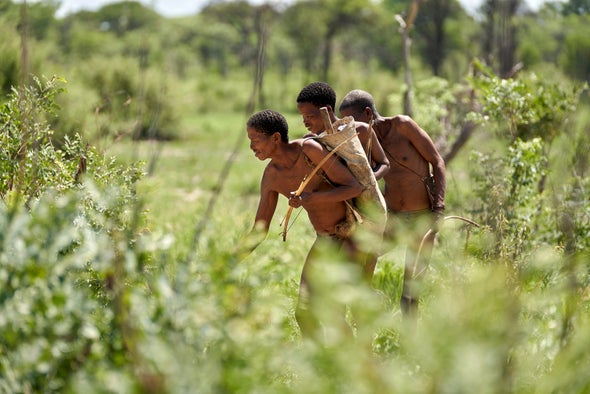 Hace aproximadamente 70 mil años en la historia de nuestra especie estuvimos al borde de la extinción, es una historia que se guarda en nuestros registros genéticos y que puso en grandes aprietos a un grupo pequeño de homo sapiens sapiens que tuvieron que ingeniárselas para sobrevivir, pero al parecer como especie resiliente, pues hoy poblamos casi todo el planeta, e incluso algunos humanos pueden encontrarse orbitando sobre él. En la actualidad más bien somos tantos que los recursos, además de desigualmente distribuidos, están siendo explotados y en algunas regiones ya los recursos vitales son escasos.
Hace aproximadamente 70 mil años en la historia de nuestra especie estuvimos al borde de la extinción, es una historia que se guarda en nuestros registros genéticos y que puso en grandes aprietos a un grupo pequeño de homo sapiens sapiens que tuvieron que ingeniárselas para sobrevivir, pero al parecer como especie resiliente, pues hoy poblamos casi todo el planeta, e incluso algunos humanos pueden encontrarse orbitando sobre él. En la actualidad más bien somos tantos que los recursos, además de desigualmente distribuidos, están siendo explotados y en algunas regiones ya los recursos vitales son escasos.
Esta situación a la que nos enfrentamos actualmente, ante un virus potencialmente contagioso y mortal, es casi repetitivo en nuestra historia, pero no esa de la cual tenemos registro desde hace 12 mil años, sino nuestra historia como especie que lleva en este planeta aproximadamente 200 mil años.
Claro está, que desde hace menos de 10 mil años el desarrollo de la cultura ha sido exponencial, y aunque somos la misma especie, la manera en cómo hemos ido enfrentando el crecimiento demográfico, la forma de aprender y adaptarnos a los entornos culturales, ha transformado de forma articulada nuestra forma de pensar y comportarnos.
Ya no somos 200 sujetos viviendo en tropas, sino que muchas de nuestras relaciones sociales se han convertido en escenarios interactivos donde nos conectamos con cientos e incluso miles de personas, y nuestra capacidad de hacer cálculos sociales a veces nos rebaza los millones de sujetos. Aunque se sabe que podemos manejar esa idea de los miles y millones de personas, hay un límite sobre el cual creamos nuestros vínculos más importantes. De ahí, que no es de extrañarse que constantemente hacemos estos contrastes entre “Nosotros” y los “Otros”, y hasta construimos diferencias donde algunas veces no existen o son culturales, claro diferencias válidas, pero no como para asumir que somos de especies diferentes o de otras razas.
Como especie ya hemos tenido que enfrentarnos a condiciones medioambientales desafiantes y a otras situaciones que han puesto en vilo nuestra supervivencia, y estos han sido actos que hemos tenido que enfrentar como especie social, aquella cuya supervivencia ha sido atribuida a nuestras habilidades sociales y nuestra capacidad de resistir como grupo. Esto no es muy diferente a lo que estamos enfrentando en la actualidad, sin embargo, resulta interesante que, ante esta crisis, el mayor acto de altruismo y empatía que podemos tener por los otros se da con el distanciamiento social y el menor contacto físico que pueda tenerse con los demás.
En este caso, nuestra mayor arma contra esta letal enfermedad sigue siendo nuestro comportamiento social, pero ya no marchamos en conjunto para combatir una situación que no sólo pone en riesgo a nuestra especie, sino que arremete con toda nuestra cultura en general. Claro está que antes de esto ya existía aislamiento social y exclusión para muchos, es para quienes dábamos por hecho nuestra existencia social que la situación nos hace repensar sobre nuestro papel en el planeta y qué acciones deberíamos tomar en adelante.
En algunos casos se ve que hay mucho optimismo por replantear e innovar sobre lo que hacemos, pero también mucha incertidumbre sobre lo que pueda venir, pues no sabemos con exactitud si esto será tomado para bien, transformando nuestro mundo sobre los errores que hemos cometido, o con la idea de volver a la normalidad y recrudecer este modelo de mundo que hemos creado, y sobre tenemos en vilo al planeta.
Hace mucho tiempo hemos dejado de pensar en las generaciones futuras, y hemos volteado nuestra mirada a la inmediatez. Pensar en nuestros hijos o nosotros mismos parece ser lo básico, pero no sobre quienes estarán (si es que estarán) en las siguientes seis u ocho generaciones. Olvidamos pensar hacia atrás, pero también hacía adelante, estamos enfocados en lo que va a pasar los siguientes meses, o añoramos nuestra vida de hace un año.
Creo que una situación como esta debería no sólo unirnos como miembros de la misma especie —cuyas decisiones colectivas pueden cambiar lo que queremos para nuestras generaciones futuras (si es que pensamos en ellas)— pero a su vez, entender que nuestra responsabilidad personal, como individuos autónomos, puede también ejercer un papel importante sobre lo que viene más adelante, sea esto para bien o para mal.
Si después de esta situación, que tiene a casi todo el mundo en el confinamiento seguimos siendo los mismos, será lamentable. Como especie hemos pasado pruebas difíciles, que como hemos visto no son recientes, sino que han sido fundamentales desde nuestra historia temprana como especie.
Seguir siendo los mismos sería trágico y decepcionante, aunque si lo hacemos no es de extrañar, pues hasta el momento hemos elegido líderes como muchos de los que tenemos, y modelos económicos, políticos y sociales que incluso que van en contra de nuestro más entrañable comportamiento social, cooperativo y altruista, e incluso contrarios a nuestra capacidad de ser críticos, autónomos y resilientes.
Tomado de: https://delfino.cr/2020/04/somos-de-los-mismos-compartimos-una-historia-como-especie



